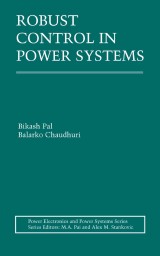Details

Robust Control in Power Systems
Power Electronics and Power Systems
|
149,79 € |
|
| Verlag: | Springer |
| Format: | |
| Veröffentl.: | 02.07.2006 |
| ISBN/EAN: | 9780387259505 |
| Sprache: | englisch |
| Anzahl Seiten: | 190 |
Dieses eBook enthält ein Wasserzeichen.
Beschreibungen
<P><STRONG>Robust Control in Power Systems</STRONG> deals with the applications of new techniques in linear system theory to control low frequency oscillations in power systems. The book specifically focuses on the analysis and damping of inter-area oscillations in the systems which are in the range of 0.2-1 Hz. The damping control action is injected through high power electronic devices known as flexible AC transmission system (FACTS) controllers. Three commonly used FACTS controllers: controllable series capacitors (CSCs) controllable phase shifters (CPSs) and static var compensators (SVCs) have been used in this book to control the inter-area oscillations. </P>
<P>The overview of linear system theory from the perspective of power system control is explained through examples. The damping control design is formulated as norm optimization problem. The H_infinity, H<SUB>2</SUB> norm of properly defined transfer functions are minimized in linear matrix inequalities (LMI) framework to obtain desired performance and stability robustness. Both centralized and decentralized control structures are used. </P>
<P>Usually the transmission of feedback signal from a remote location encounters delays making it difficult to control the system. Smith predictor based approach has been successfully explored in this book as a solution to such a problem.</P>
<P><STRONG>Robust Control in Power Systems</STRONG> will be valuable to academicians in the areas of power, control and system theory, as well as professionals in the power industry.</P>
<P>The overview of linear system theory from the perspective of power system control is explained through examples. The damping control design is formulated as norm optimization problem. The H_infinity, H<SUB>2</SUB> norm of properly defined transfer functions are minimized in linear matrix inequalities (LMI) framework to obtain desired performance and stability robustness. Both centralized and decentralized control structures are used. </P>
<P>Usually the transmission of feedback signal from a remote location encounters delays making it difficult to control the system. Smith predictor based approach has been successfully explored in this book as a solution to such a problem.</P>
<P><STRONG>Robust Control in Power Systems</STRONG> will be valuable to academicians in the areas of power, control and system theory, as well as professionals in the power industry.</P>
Power System Oscillations.- Linear Control in Power Systems.- Test System Model.- Power System Stabilizers.- Multiple-Model Adaptive Control Approach.- Simultaneous Stabilization.- Mixed-Sensitivity Approach Using Linear Matrix Inequalities.- Normalized ?? Loop-Shaping Using Linear Matrix Inequalities.- ?? Control For Time-Delayed Systems.
<P><EM><STRONG>Robust Control in Power Systems</STRONG></EM> deals with the applications of new techniques in linear system theory to control low frequency oscillations in power systems. The book specifically focuses on the analysis and damping of inter-area oscillations in the systems which are in the range of 0.2-1 Hz. The damping control action is injected through high power electronic devices known as flexible AC transmission system (FACTS) controllers. Three commonly used FACTS controllers: controllable series capacitors (CSCs) controllable phase shifters (CPSs) and static var compensators (SVCs) have been used in this book to control the inter-area oscillations. </P>
<P>The overview of linear system theory from the perspective of power system control is explained through examples. The damping control design is formulated as norm optimization problem. The H_infinity, H<SUB>2</SUB> norm of properly defined transfer functions are minimized in linear matrix inequalities (LMI) framework to obtain desired performance and stability robustness. Both centralized and decentralized control structures are used. </P>
<P>Usually the transmission of feedback signal from a remote location encounters delays making it difficult to control the system. Smith predictor based approach has been successfully explored in this book as a solution to such a problem.</P>
<P><EM><STRONG>Robust Control in Power Systems</STRONG></EM> will be valuable to academicians in the areas of power, control and system theory, as well as professionals in the power industry.</P>
<P>The overview of linear system theory from the perspective of power system control is explained through examples. The damping control design is formulated as norm optimization problem. The H_infinity, H<SUB>2</SUB> norm of properly defined transfer functions are minimized in linear matrix inequalities (LMI) framework to obtain desired performance and stability robustness. Both centralized and decentralized control structures are used. </P>
<P>Usually the transmission of feedback signal from a remote location encounters delays making it difficult to control the system. Smith predictor based approach has been successfully explored in this book as a solution to such a problem.</P>
<P><EM><STRONG>Robust Control in Power Systems</STRONG></EM> will be valuable to academicians in the areas of power, control and system theory, as well as professionals in the power industry.</P>
Application of an important research area of Control and System Theory to power system problem Possible course at Grad level in Power and a reading material in a Control theory course First book in power area to discuss robust design of controllers in a power network Starting point for new researchers initiating research in this area Includes supplementary material: sn.pub/extras
Diese Produkte könnten Sie auch interessieren:

Ermittlung der Wicklungstemperatur einer neunphasigen Synchronmaschine mit COMSOL

von: Yvonne Schröder

18,99 €
















